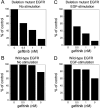In-frame deletion in the EGF receptor alters kinase inhibition by gefitinib
- PMID: 16623663
- PMCID: PMC1533307
- DOI: 10.1042/BJ20051962
In-frame deletion in the EGF receptor alters kinase inhibition by gefitinib
Abstract
The existence of an in-frame deletion mutant correlates with the sensitivity of lung cancers to EGFR (epidermal growth factor receptor)-targeted tyrosine kinase inhibitors. We reported previously that the in-frame 15-bp deletional mutation (delE746-A750 type deletion) was constitutively active in cells. Kinetic parameters are important for characterizing an enzyme; however, it remains unclear whether the kinetic parameters of deletion mutant EGFR are similar to those of wild-type EGFR. We analysed autophosphorylation in response to ATP and inhibition of gefitinib for deletion mutant EGFR and wild-type EGFR. Kinetic studies, examining autophosphorylation, were carried out using EGFR fractions extracted from 293-pDelta15 and 293-pEGFR cells transfected with deletion mutant EGFR and wild-type EGFR respectively. We demonstrated the difference in activities between unstimulated wild-type (K(m) for ATP=4.0+/-0.3 microM) and mutant EGFR (K(m) for ATP=2.5+/-0.2 microM). There was no difference in K(m) values between EGF-stimulated wild-type EGFR (K(m) for ATP=1.9+/-0.1 microM) and deletion mutant EGFR (K(m) for ATP=2.2+/-0.2 microM). These results suggest that mutant EGFR is active without ligand stimulation. The K(i) value for gefitinib of the deletion mutant EGFR was much lower than that of wild-type EGFR. These results suggest that the deletion mutant EGFR has a higher affinity for gefitinib than wild-type EGFR.
Figures






Similar articles
-
Temporal resolution of autophosphorylation for normal and oncogenic forms of EGFR and differential effects of gefitinib.Biochemistry. 2012 Jun 26;51(25):5212-22. doi: 10.1021/bi300476v. Epub 2012 Jun 13. Biochemistry. 2012. PMID: 22657099 Free PMC article.
-
Small in-frame deletion in the epidermal growth factor receptor as a target for ZD6474.Cancer Res. 2004 Dec 15;64(24):9101-4. doi: 10.1158/0008-5472.CAN-04-2360. Cancer Res. 2004. PMID: 15604279
-
Dimerization and the signal transduction pathway of a small in-frame deletion in the epidermal growth factor receptor.FASEB J. 2006 Feb;20(2):311-3. doi: 10.1096/fj.05-4034fje. Epub 2005 Dec 22. FASEB J. 2006. PMID: 16373402
-
Using the MCF10A/MCF10CA1a Breast Cancer Progression Cell Line Model to Investigate the Effect of Active, Mutant Forms of EGFR in Breast Cancer Development and Treatment Using Gefitinib.PLoS One. 2015 May 13;10(5):e0125232. doi: 10.1371/journal.pone.0125232. eCollection 2015. PLoS One. 2015. PMID: 25969993 Free PMC article.
-
An update of the mechanisms of resistance to EGFR-tyrosine kinase inhibitors in breast cancer: Gefitinib (Iressa) -induced changes in the expression and nucleo-cytoplasmic trafficking of HER-ligands (Review).Int J Mol Med. 2007 Jul;20(1):3-10. Int J Mol Med. 2007. PMID: 17549382 Review.
Cited by
-
Theoretical method for evaluation of therapeutic effects and adverse effects of epidermal growth factor receptor tyrosine kinase inhibitors in clinical treatment.Med Oncol. 2017 Sep 8;34(10):178. doi: 10.1007/s12032-017-1036-9. Med Oncol. 2017. PMID: 28887613
-
Epidermal growth factor receptor mutation in combination with expression of MIG6 alters gefitinib sensitivity.BMC Syst Biol. 2011 Feb 18;5:29. doi: 10.1186/1752-0509-5-29. BMC Syst Biol. 2011. PMID: 21333004 Free PMC article.
-
Temporal resolution of autophosphorylation for normal and oncogenic forms of EGFR and differential effects of gefitinib.Biochemistry. 2012 Jun 26;51(25):5212-22. doi: 10.1021/bi300476v. Epub 2012 Jun 13. Biochemistry. 2012. PMID: 22657099 Free PMC article.
-
Epidermal growth factor receptor lacking C-terminal autophosphorylation sites retains signal transduction and high sensitivity to epidermal growth factor receptor tyrosine kinase inhibitor.Cancer Sci. 2009 Mar;100(3):552-7. doi: 10.1111/j.1349-7006.2008.01071.x. Epub 2009 Jan 14. Cancer Sci. 2009. PMID: 19154417 Free PMC article.
-
N-Glycan fucosylation of epidermal growth factor receptor modulates receptor activity and sensitivity to epidermal growth factor receptor tyrosine kinase inhibitor.Cancer Sci. 2008 Aug;99(8):1611-7. doi: 10.1111/j.1349-7006.2008.00847.x. Cancer Sci. 2008. PMID: 18754874 Free PMC article.
References
-
- Arteaga C. L. ErbB-targeted therapeutic approaches in human cancer. Exp. Cell Res. 2003;284:122–130. - PubMed
-
- Traxler P., Furet P., Mett H., Buchdunger E., Meyer T., Lydon N. Design and synthesis of novel tyrosine kinase inhibitors using a pharmacophore model of the ATP-binding site of the EGF-R. J. Pharm. Belg. 1997;52:88–96. - PubMed
-
- Shepherd F. A., Rodrigues Pereira J., Ciuleanu T., Tan E. H., Hirsh V., Thongprasert S., Campos D., Maoleekoonpiroj S., Smylie M., Martins R., et al. Erlotinib in previously treated non-small-cell lung cancer. N. Engl. J. Med. 2005;353:123–132. - PubMed
-
- Bell D. W., Lynch T. J., Haserlat S. M., Harris P. L., Okimoto R. A., Brannigan B. W., Sgroi D. C., Muir B., Riemenschneider M. J., Iacona R. B., et al. Epidermal growth factor receptor mutations and gene amplification in non-small-cell lung cancer: molecular analysis of the IDEAL/INTACT gefitinib trials. J. Clin. Oncol. 2005;23:8081–8092. - PubMed
-
- Lynch T. J., Bell D. W., Sordella R., Gurubhagavatula S., Okimoto R. A., Brannigan B. W., Harris P. L., Haserlat S. M., Supko J. G., Haluska F. G., et al. Activating mutations in the epidermal growth factor receptor underlying responsiveness of non-small-cell lung cancer to gefitinib. N. Engl. J. Med. 2004;350:2129–2139. - PubMed
Publication types
MeSH terms
Substances
LinkOut - more resources
Full Text Sources
Research Materials
Miscellaneous

